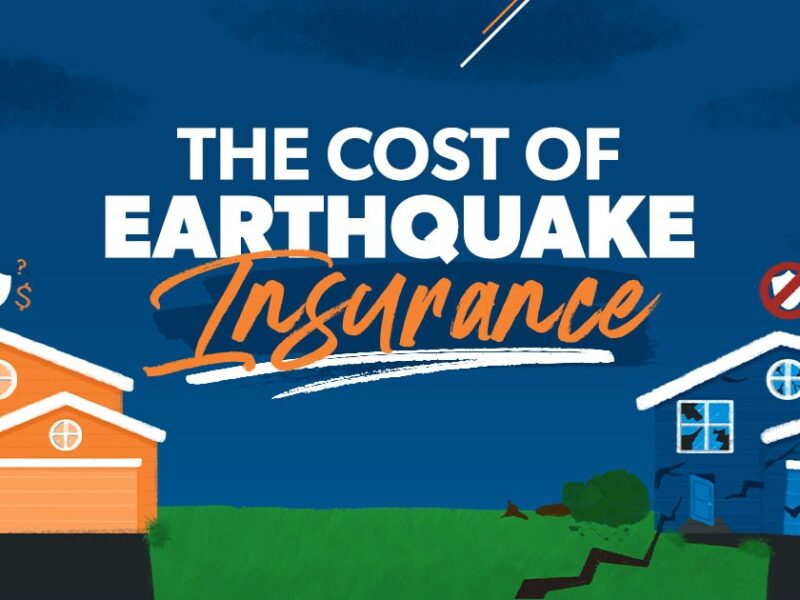Types of Earthquake Insurance
1. Standard Earthquake Insurance Policies
These are the most common type of earthquake insurance in the US. They typically cover structural damage to your home, including repairs to the foundation, walls and roof. Standard policies also cover the cost of replacing or repairing damaged personal property, such as furniture and appliances.
2. Extended Coverage Policies
For those seeking more comprehensive protection, extended coverage policies offer additional benefits beyond what standard policies provide. This can include coverage for loss of use, which helps cover living expenses if your home becomes uninhabitable and additional protection for high-value items like art collections or expensive jewelry.
3. Business Earthquake Insurance
Businesses also need protection against seismic risks. Business earthquake insurance is designed to cover damage to commercial properties and equipment. It often includes loss of income coverage, which helps compensate for revenue lost due to business interruptions caused by earthquakes.
4. Earthquake Insurance Endorsements
In some cases, homeowners or business owners may add an earthquake endorsement to their existing insurance policies. This endorsement modifies the terms of the standard policy to include earthquake coverage, often at a lower cost than purchasing a separate policy.
How Earthquake Insurance Works
Understanding how earthquake insurance works can help you make informed decisions about your coverage. Here’s a breakdown of the key components:
1. Coverage Limits
Earthquake insurance policies come with coverage limits, which is the maximum amount the insurer will pay for a covered loss. These limits are set based on the value of your home or business and the extent of coverage you choose. It’s crucial to select a coverage limit that accurately reflects the potential cost of repairs or replacements.
2. Deductibles
Earthquake insurance policies typically have deductibles, which is the amount you must pay out-of-pocket before the insurance kicks in. Deductibles for earthquake insurance are usually higher than those for other types of insurance, often ranging from 5% to 20% of the total coverage amount.
3. Claims Process
When an earthquake causes damage to your property, you’ll need to file a claim with your insurance company. The claims process involves documenting the damage, obtaining repair estimates and working with adjusters to assess the loss. Promptly reporting the damage and providing thorough documentation can help ensure a smoother claims process.
4. Exclusions and Limitations
Like all insurance policies, earthquake insurance comes with exclusions and limitations. Common exclusions include damage to certain types of property or structural components, such as swimming pools or fences. It’s essential to review your policy carefully to understand what’s covered and what’s not.
Criteria for Obtaining Earthquake Insurance
1. Geographic Location
One of the primary criteria for obtaining earthquake insurance is your geographic location. Areas with a high risk of seismic activity, such as California, Alaska and the Pacific Northwest, are more likely to require earthquake insurance. Insurance companies often use geological data to assess the risk level for specific regions.
2. Property Type
The type of property you own can also impact your eligibility for earthquake insurance. For instance, older homes or buildings that are not retrofitted to withstand earthquakes may face higher premiums or stricter underwriting requirements.
3. Building Code Compliance
Properties that meet modern building codes for earthquake resistance may qualify for lower premiums. Insurers often look for features such as reinforced foundations or retrofitted structural components when evaluating risk.
4. Insurance History
Your history with insurance, including past claims and overall risk profile, can influence your ability to obtain earthquake insurance. Maintaining a good insurance record and managing risk effectively can work in your favor.
Application Process for Earthquake Insurance
1. Research and Compare Policies
The first step in applying for earthquake insurance is to research and compare different policies. Look for insurers that offer comprehensive coverage options and compare the benefits, coverage limits and deductibles.
2. Request a Quote
Once you’ve identified potential insurers, request quotes for earthquake insurance. Insurers will typically ask for details about your property, including its location, age and construction type, to provide an accurate quote.
3. Complete the Application
After receiving quotes, complete the application process. This may involve providing additional documentation, such as proof of property value or a recent home inspection report. Be honest and thorough in your application to avoid potential issues with coverage.
4. Review and Sign the Policy
Before finalizing your policy, carefully review the terms and conditions. Ensure that you understand the coverage limits, deductibles and any exclusions. Once satisfied, sign the policy documents and make your initial premium payment.
Benefits of Earthquake Insurance
1. Financial Protection
The primary benefit of earthquake insurance is financial protection. Earthquakes can cause extensive damage to property and without insurance, you could face significant out-of-pocket expenses. Earthquake insurance helps mitigate these costs and provides peace of mind.
2. Coverage for Additional Expenses
In addition to covering repair costs, earthquake insurance often includes coverage for additional expenses, such as temporary housing. This can be especially valuable if your home is uninhabitable for an extended period.
3. Property Value Preservation
Maintaining earthquake insurance helps preserve the value of your property. In the event of significant damage, the insurance can cover repair costs, ensuring that your property retains its market value.
4. Business Continuity
For businesses, earthquake insurance can be crucial for maintaining continuity. Coverage for loss of income and damage to commercial properties helps businesses recover more quickly and resume operations after an earthquake.
Companies Offering Earthquake Insurance in the US
Several companies specialize in providing earthquake insurance across the US. Here are some of the leading insurers in the market:
1. State Farm
State Farm is one of the largest insurance providers in the US and offers earthquake insurance as part of its portfolio. They provide comprehensive coverage options, including repair costs, personal property replacement and temporary living expenses.
2. Allstate
Allstate offers earthquake insurance with various coverage levels to suit different needs. Their policies often include additional coverage options, such as enhanced protection for high-value items and coverage for business interruptions.
3. Liberty Mutual
Liberty Mutual provides earthquake insurance with a focus on flexibility and customization. They offer policies that can be tailored to include extended coverage options, ensuring that policyholders have the protection they need.
4. The Hartford
The Hartford is known for its business insurance solutions, including earthquake coverage for commercial properties. They offer policies designed to address the unique risks faced by businesses in earthquake-prone areas.
5. Farmers Insurance
Farmers Insurance offers earthquake insurance with a variety of coverage options. They provide policies that cover structural damage, personal property and additional living expenses, catering to both homeowners and businesses.
Earthquake insurance in the US is more than just a safety net; it’s a critical component of financial preparedness for those living in seismic regions. By understanding the different types of coverage, how it works and the benefits it offers, you can make informed decisions about protecting your property and finances from the unpredictable nature of earthquakes. Whether you’re a homeowner or business owner, investing in earthquake insurance ensures that you’re better equipped to handle the impact of seismic events, giving you peace of mind and financial security.
FAQs
How much does earthquake insurance cost?
The cost of earthquake insurance varies based on factors like the location of your property, its value, the level of coverage you choose and the deductible amount. Premiums in high-risk areas tend to be higher. On average, homeowners can expect to pay between $800 and $2,500 annually, depending on these factors.
What is a deductible in earthquake insurance?
A deductible is the amount you must pay out-of-pocket before your earthquake insurance coverage kicks in. Deductibles for earthquake insurance are typically higher than those for other types of insurance, often ranging from 5% to 20% of the total coverage amount. For example, if your coverage limit is $100,000 and your deductible is 10%, you would need to pay $10,000 before insurance covers the rest.
Does earthquake insurance cover damage to landscaping or swimming pools?
Standard earthquake insurance policies usually do not cover damage to landscaping, swimming pools or other outdoor features. Coverage is generally limited to the structure of the home or business and its contents. However, some policies may offer optional add-ons or endorsements to include such items, so it’s important to review your policy details.
How can I determine if I need earthquake insurance?
If you live in an area prone to earthquakes, such as California or Alaska, it’s wise to consider earthquake insurance. Check the seismic risk level of your location and evaluate your property’s vulnerability. For those in lower-risk areas, assess the potential financial impact of an earthquake and determine if the cost of insurance justifies the protection it offers.
How do I file a claim for earthquake damage?
To file a claim, promptly contact your insurance provider to report the damage. Document the damage thoroughly with photos and obtain repair estimates. An adjuster from the insurance company will assess the damage and determine the payout based on your policy’s coverage limits and deductibles. Keep records of all communications and repairs for a smooth claims process.
Are there any exclusions in earthquake insurance policies?
Yes, earthquake insurance policies often come with exclusions and limitations. Common exclusions include damage to certain types of property, like fences or swimming pools and damage from aftershocks. Some policies may also exclude coverage for pre-existing damage or damage due to poor maintenance. Review your policy carefully to understand these limitations.
Can I get earthquake insurance if my home is older or has not been retrofitted?
Yes, you can still obtain earthquake insurance for an older home or one that has not been retrofitted, but premiums may be higher. Insurance companies assess the risk based on the property’s age, construction type and seismic retrofitting. Retrofitting your home to meet modern building codes can potentially lower your premiums and improve your coverage options.
Which companies offer earthquake insurance in the US?
Several companies provide earthquake insurance across the US. Notable insurers include State Farm, Allstate, Liberty Mutual, The Hartford and Farmers Insurance. Each offers various coverage options and benefits, so it’s essential to compare policies, review coverage limits and assess deductibles to find the best fit for your needs.





